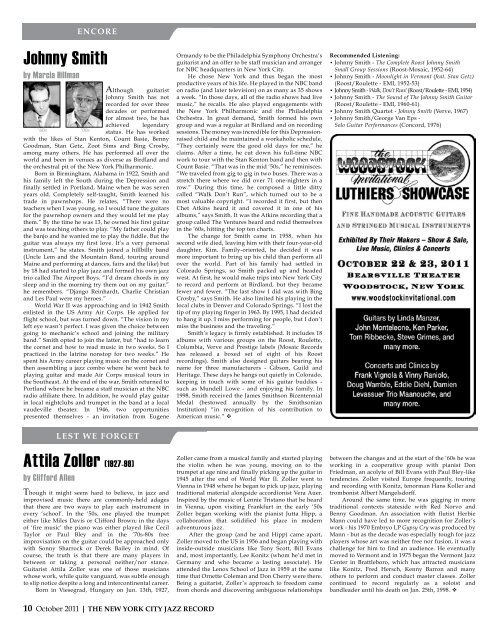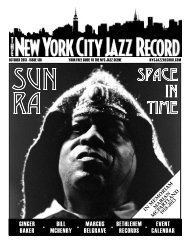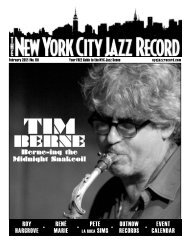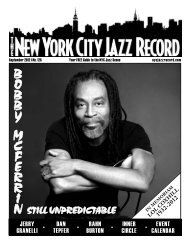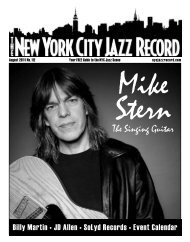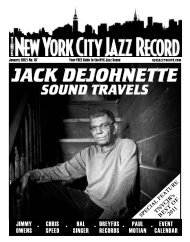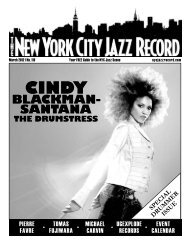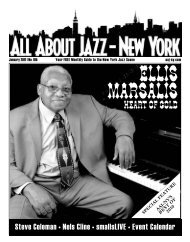Return of the Guitar Man - The New York City Jazz Record
Return of the Guitar Man - The New York City Jazz Record
Return of the Guitar Man - The New York City Jazz Record
Create successful ePaper yourself
Turn your PDF publications into a flip-book with our unique Google optimized e-Paper software.
ENCORE<br />
Johnny Smith<br />
by Marcia Hillman<br />
Although guitarist<br />
Johnny Smith has not<br />
recorded for over three<br />
decades or performed<br />
for almost two, he has<br />
achieved legendary<br />
‘60s ‘00s<br />
status. He has worked<br />
with <strong>the</strong> likes <strong>of</strong> Stan Kenton, Count Basie, Benny<br />
Goodman, Stan Getz, Zoot Sims and Bing Crosby,<br />
among many o<strong>the</strong>rs. He has performed all over <strong>the</strong><br />
world and been in venues as diverse as Birdland and<br />
<strong>the</strong> orchestral pit <strong>of</strong> <strong>the</strong> <strong>New</strong> <strong>York</strong> Philharmonic.<br />
Born in Birmingham, Alabama in 1922, Smith and<br />
his family left <strong>the</strong> South during <strong>the</strong> Depression and<br />
finally settled in Portland, Maine when he was seven<br />
years old. Completely self-taught, Smith learned his<br />
trade in pawnshops. He relates, “<strong>The</strong>re were no<br />
teachers when I was young, so I would tune <strong>the</strong> guitars<br />
for <strong>the</strong> pawnshop owners and <strong>the</strong>y would let me play<br />
<strong>the</strong>m.” By <strong>the</strong> time he was 13, he owned his first guitar<br />
and was teaching o<strong>the</strong>rs to play. “My fa<strong>the</strong>r could play<br />
<strong>the</strong> banjo and he wanted me to play <strong>the</strong> fiddle. But <strong>the</strong><br />
guitar was always my first love. It’s a very personal<br />
instrument,” he states. Smith joined a hillbilly band<br />
(Uncle Lem and <strong>the</strong> Mountain Band, touring around<br />
Maine and performing at dances, fairs and <strong>the</strong> like) but<br />
by 18 had started to play jazz and formed his own jazz<br />
trio called <strong>The</strong> Airport Boys. “I’d dream chords in my<br />
sleep and in <strong>the</strong> morning try <strong>the</strong>m out on my guitar,”<br />
he remembers. “Django Reinhardt, Charlie Christian<br />
and Les Paul were my heroes.”<br />
World War II was approaching and in 1942 Smith<br />
enlisted in <strong>the</strong> US Army Air Corps. He applied for<br />
flight school, but was turned down. “<strong>The</strong> vision in my<br />
left eye wasn’t perfect. I was given <strong>the</strong> choice between<br />
going to mechanic’s school and joining <strong>the</strong> military<br />
band.” Smith opted to join <strong>the</strong> latter, but “had to learn<br />
<strong>the</strong> cornet and how to read music in two weeks. So I<br />
practiced in <strong>the</strong> latrine nonstop for two weeks.” He<br />
spent his Army career playing music on <strong>the</strong> cornet and<br />
<strong>the</strong>n assembling a jazz combo where he went back to<br />
playing guitar and made Air Corps musical tours in<br />
<strong>the</strong> Sou<strong>the</strong>ast. At <strong>the</strong> end <strong>of</strong> <strong>the</strong> war, Smith returned to<br />
Portland where he became a staff musician at <strong>the</strong> NBC<br />
radio affiliate <strong>the</strong>re. In addition, he would play guitar<br />
in local nightclubs and trumpet in <strong>the</strong> band at a local<br />
vaudeville <strong>the</strong>ater. In 1946, two opportunities<br />
presented <strong>the</strong>mselves - an invitation from Eugene<br />
LEST WE FORGET<br />
Attila Zoller (1927-98)<br />
by Clifford Allen<br />
Though it might seem hard to believe, in jazz and<br />
improvised music <strong>the</strong>re are commonly-held adages<br />
that <strong>the</strong>re are two ways to play each instrument in<br />
every ‘school’. In <strong>the</strong> ‘50s, one played <strong>the</strong> trumpet<br />
ei<strong>the</strong>r like Miles Davis or Clifford Brown; in <strong>the</strong> days<br />
<strong>of</strong> ‘fire music’ <strong>the</strong> piano was ei<strong>the</strong>r played like Cecil<br />
Taylor or Paul Bley and in <strong>the</strong> ’70s-80s free<br />
improvisation on <strong>the</strong> guitar could be approached only<br />
with Sonny Sharrock or Derek Bailey in mind. Of<br />
course, <strong>the</strong> truth is that <strong>the</strong>re are many players in<br />
between or taking a personal nei<strong>the</strong>r/nor stance.<br />
<strong>Guitar</strong>ist Attila Zoller was one <strong>of</strong> those musicians<br />
whose work, while quite vanguard, was subtle enough<br />
to slip notice despite a long and intercontinental career.<br />
Born in Viesegrad, Hungary on Jun. 13th, 1927,<br />
10 October 2011 | THE NEW YORK CITY JAZZ RECORD<br />
Ormandy to be <strong>the</strong> Philadelphia Symphony Orchestra’s<br />
guitarist and an <strong>of</strong>fer to be staff musician and arranger<br />
for NBC headquarters in <strong>New</strong> <strong>York</strong> <strong>City</strong>.<br />
He chose <strong>New</strong> <strong>York</strong> and thus began <strong>the</strong> most<br />
productive years <strong>of</strong> his life. He played in <strong>the</strong> NBC band<br />
on radio (and later television) on as many as 35 shows<br />
a week. “In those days, all <strong>of</strong> <strong>the</strong> radio shows had live<br />
music,” he recalls. He also played engagements with<br />
<strong>the</strong> <strong>New</strong> <strong>York</strong> Philharmonic and <strong>the</strong> Philadelphia<br />
Orchestra. In great demand, Smith formed his own<br />
group and was a regular at Birdland and on recording<br />
sessions. <strong>The</strong> money was incredible for this Depressionraised<br />
child and he maintained a workaholic schedule.<br />
“<strong>The</strong>y certainly were <strong>the</strong> good old days for me,” he<br />
claims. After a time, he cut down his full-time NBC<br />
work to tour with <strong>the</strong> Stan Kenton band and <strong>the</strong>n with<br />
Count Basie. “That was in <strong>the</strong> mid ‘50s,” he reminisces.<br />
“We traveled from gig to gig in two buses. <strong>The</strong>re was a<br />
stretch <strong>the</strong>re where we did over 71 one-nighters in a<br />
row.” During this time, he composed a little ditty<br />
called “Walk Don’t Run”, which turned out to be a<br />
most valuable copyright. “I recorded it first, but <strong>the</strong>n<br />
Chet Atkins heard it and covered it in one <strong>of</strong> his<br />
albums,” says Smith. It was <strong>the</strong> Atkins recording that a<br />
group called <strong>The</strong> Ventures heard and redid <strong>the</strong>mselves<br />
in <strong>the</strong> ‘60s, hitting <strong>the</strong> top ten charts.<br />
<strong>The</strong> change for Smith came in 1958, when his<br />
second wife died, leaving him with <strong>the</strong>ir four-year-old<br />
daughter, Kim. Family-oriented, he decided it was<br />
more important to bring up his child than perform all<br />
over <strong>the</strong> world. Part <strong>of</strong> his family had settled in<br />
Colorado Springs, so Smith packed up and headed<br />
west. At first, he would make trips into <strong>New</strong> <strong>York</strong> <strong>City</strong><br />
to record and perform at Birdland, but <strong>the</strong>y became<br />
fewer and fewer. “<strong>The</strong> last show I did was with Bing<br />
Crosby,” says Smith. He also limited his playing in <strong>the</strong><br />
local clubs in Denver and Colorado Springs. “I lost <strong>the</strong><br />
tip <strong>of</strong> my playing finger in 1963. By 1995, I had decided<br />
to hang it up. I miss performing for people, but I don’t<br />
miss <strong>the</strong> business and <strong>the</strong> traveling.”<br />
Smith’s legacy is firmly established. It includes 18<br />
albums with various groups on <strong>the</strong> Roost, Roulette,<br />
Columbia, Verve and Prestige labels (Mosaic <strong>Record</strong>s<br />
has released a boxed set <strong>of</strong> eight <strong>of</strong> his Roost<br />
recordings). Smith also designed guitars bearing his<br />
name for three manufacturers - Gibson, Guild and<br />
Heritage. <strong>The</strong>se days he hangs out quietly in Colorado,<br />
keeping in touch with some <strong>of</strong> his guitar buddies -<br />
such as Mundell Lowe - and enjoying his family. In<br />
1998, Smith received <strong>the</strong> James Smithson Bicentennial<br />
Medal (bestowed annually by <strong>the</strong> Smithsonian<br />
Institution) “in recognition <strong>of</strong> his contribution to<br />
American music.” v<br />
Zoller came from a musical family and started playing<br />
<strong>the</strong> violin when he was young, moving on to <strong>the</strong><br />
trumpet at age nine and finally picking up <strong>the</strong> guitar in<br />
1945 after <strong>the</strong> end <strong>of</strong> World War II. Zoller went to<br />
Vienna in 1948 where he began to pick up jazz, playing<br />
traditional material alongside accordionist Vera Auer.<br />
Inspired by <strong>the</strong> music <strong>of</strong> Lennie Tristano that he heard<br />
in Vienna, upon visiting Frankfurt in <strong>the</strong> early ‘50s<br />
Zoller began working with <strong>the</strong> pianist Jutta Hipp, a<br />
collaboration that solidified his place in modern<br />
adventurous jazz.<br />
After <strong>the</strong> group (and he and Hipp) came apart,<br />
Zoller moved to <strong>the</strong> US in 1956 and began playing with<br />
inside-outside musicians like Tony Scott, Bill Evans<br />
and, most importantly, Lee Konitz (whom he’d met in<br />
Germany and who became a lasting associate). He<br />
attended <strong>the</strong> Lenox School <strong>of</strong> <strong>Jazz</strong> in 1959 at <strong>the</strong> same<br />
time that Ornette Coleman and Don Cherry were <strong>the</strong>re.<br />
Being a guitarist, Zoller’s approach to freedom came<br />
from chords and discovering ambiguous relationships<br />
Recommended Listening:<br />
• Johnny Smith - <strong>The</strong> Complete Roost Johnny Smith<br />
Small Group Sessions (Roost-Mosaic, 1952-64)<br />
• Johnny Smith - Moonlight in Vermont (feat. Stan Getz)<br />
(Roost/Roulette - EMI, 1952-53)<br />
• Johnny Smith - Walk, Don’t Run! (Roost/Roulette - EMI, 1954)<br />
• Johnny Smith - <strong>The</strong> Sound <strong>of</strong> <strong>The</strong> Johnny Smith <strong>Guitar</strong><br />
(Roost/Roulette - EMI, 1960-61)<br />
• Johnny Smith Quartet - Johnny Smith (Verve, 1967)<br />
• Johnny Smith/George Van Eps -<br />
Solo <strong>Guitar</strong> Performances (Concord, 1976)<br />
between <strong>the</strong> changes and at <strong>the</strong> start <strong>of</strong> <strong>the</strong> ‘60s he was<br />
working in a cooperative group with pianist Don<br />
Friedman, an acolyte <strong>of</strong> Bill Evans with Paul Bley-like<br />
tendencies. Zoller visited Europe frequently, touring<br />
and recording with Konitz, tenorman Hans Koller and<br />
trombonist Albert <strong>Man</strong>gelsdorff.<br />
Around <strong>the</strong> same time, he was gigging in more<br />
traditional contexts stateside with Red Norvo and<br />
Benny Goodman. An association with flutist Herbie<br />
<strong>Man</strong>n could have led to more recognition for Zoller’s<br />
work - his 1970 Embryo LP Gypsy Cry was produced by<br />
<strong>Man</strong>n - but as <strong>the</strong> decade was especially tough for jazz<br />
players whose art was nei<strong>the</strong>r free nor fusion, it was a<br />
challenge for him to find an audience. He eventually<br />
moved to Vermont and in 1975 began <strong>the</strong> Vermont <strong>Jazz</strong><br />
Center in Brattleboro, which has attracted musicians<br />
like Konitz, Fred Hersch, Kenny Barron and many<br />
o<strong>the</strong>rs to perform and conduct master classes. Zoller<br />
continued to record regularly as a soloist and<br />
bandleader until his death on Jan. 25th, 1998. v


